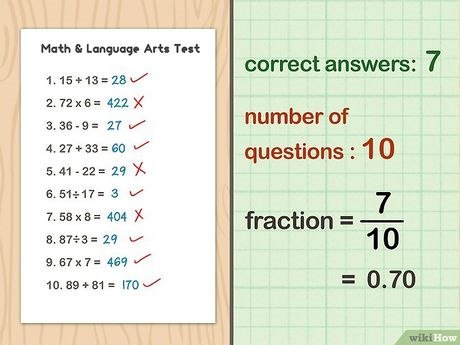Understanding how grades are calculated for tests is crucial for students, teachers, and parents alike. It allows one to gauge performance, set realistic expectations, and identify areas in need of improvement. The process might seem daunting at first, but once broken down into comprehensible steps, it becomes much more manageable. Grasping these concepts not only can help in academic planning but also instill a sense of control over one’s educational journey.

Standard Percentage Method
Before diving into the various ways you can calculate test grades, let’s understand the traditional percentage method that’s widely used. This method involves assigning a value to each question and calculating the percentage of points earned out of the total possible points.
- Identify total points: Begin by determining the total number of points possible on the test.
- Sum the points earned: Tally up the number of points you’ve scored on the test.
- Divide by the total possible points: Take your earned points and divide them by the total points possible.
- Multiply by 100: To get your percentage, multiply the result from step 3 by 100.
Summary: The Standard Percentage Method is straightforward and provides a clear percentage that’s easy to understand. However, this method doesn’t account for weighted questions or sections and assumes all questions carry the same value.
Weighted Score Approach
Some tests have questions that are more important than others, which is where the Weighted Score Approach comes in. This method assigns different values to different sections or types of questions.
- Identify section weights: Note which sections carry more weight, usually indicated by the test instructions.
- Calculate section scores: Tally the points earned in each section.
- Calculate weighted scores: Multiply each section score by its respective weight.
- Sum weighted scores: Add all the weighted scores together.
- Divide by total possible weighted points: Similar to the standard method, you divide your summed score by the total possible weighted points, then multiply by 100 for the percentage.
Summary: The Weighted Score Approach is beneficial for tests with unevenly valued sections but requires careful attention to detail. Missing the weight of a section can lead to an incorrect calculation.
Point Reduction Method
For those who find it easier to count mistakes rather than correct answers, the Point Reduction Method could be a simpler alternative.
- Begin with total points: Start with the total number of points possible.
- Subtract points lost: For every question missed, subtract its value from the total points possible.
- Calculate percentage: Divide the remaining points by the total points possible and then multiply by 100.
Summary: This method is especially good for quick calculations on tests with equal question values. However, it’s not ideal for tests with weighted sections.
Using Excel or Google Sheets
Spreadsheets like Excel or Google Sheets can make grade calculation automatic once you set up the necessary formulas.
- Setup your spreadsheet: Create a spreadsheet with separate columns for questions, points per question, and points earned.
- Enter your data: Fill in each column with the appropriate data from your test.
- Enter a formula: Use a formula to calculate the sum of points earned and divide it by the sum of the total points possible.
- Format the percentage: Ensure the cell with the formula is formatted to show a percentage.
Summary: Utilizing a spreadsheet automates the process, which is excellent for minimizing human error. However, setting up the formulas initially requires some basic understanding of how spreadsheet software works.
Class Average Calculation
Understanding individual grades is one thing, but sometimes you’ll need to calculate the class average for a test.
- Sum individual scores: Add together the scores of all students.
- Count the number of students: Determine how many students took the test.
- Divide scores by number of students: Divide the total sum of scores by the number of students.
Summary: Class average calculations provide a valuable metric for overall performance and can help identify tests that may have been too easy or difficult. However, the average might not accurately represent the distribution of scores.
Letter Grade Determination
Once you have a percentage, you might need to translate this into a letter grade based on your school or institution’s grading scale.
- Determine the grading scale: Make sure you understand the range of percentages that correspond to each letter grade.
- Match percentage to scale: Find where your test score falls within this scale.
- Assign letter grade: Assign the appropriate letter grade based on the grading scale.
Summary: This translation to letter grades allows for quick comprehension of performance, though it does not provide nuanced feedback like percentages or points do.
Incremental Improvement Tracking
It’s useful to track progress over time, which means comparing current grades to past ones to see improvement.
- Record past grades: Keep a list of past percentages or points.
- Compare with current grade: Analyze your most recent grade in relation to past ones.
- Calculate the difference: This shows you whether there’s an upward or downward trend.
Summary: This method helps in setting and meeting personal goals, although it requires consistent record-keeping to be effective.
Grading Curve Application
Occasionally, you might need to apply a grading curve to a test score based on overall class performance.
- Understand the curve method: There are several methods, so know which one is being applied.
- Alter scores accordingly: Adjust scores based on the method chosen, which could be adding points to all scores or changing the grading scale.
- Recalculate grades: Recalculate your percentage or letter grade post-curve.
Summary: Curving can help normalize an exceptionally difficult test, but it can also cause controversy if students feel their efforts are not being accurately reflected.
Bonus Points Integration
If your test includes opportunities for extra credit, integrating these into your final grade is important.
- Record earned bonus points: Keep a precise count of any extra credit points.
- Add to your scored points: Before calculating the percentage, add these to your earned points.
- Calculate new percentage: Use the modified score for a more accurate percentage.
Summary: This reflects a student’s full effort including extra credit, but it’s essential to balance bonus points so they don’t disproportionately affect the grade.
Practice Test Comparison
Using practice tests as a baseline for improvement can be a great way to prepare for the real thing.
- Measure practice test results: Take note of your scores on practice tests.
- Identify areas of improvement: Look for patterns in the types of questions missed.
- Apply this knowledge: Use this insight to focus your studying on weak areas.
Summary: Practice tests can be an excellent predictor of actual test performance, provided the practice material closely aligns with what is being tested.
Conclusion
Calculating test grades need not leave you feeling bewildered. By familiarizing yourself with these methods and applying the ones best suited to your needs, you can easily decipher your performance and track your academic progress. Each method is a tool at your disposal, ready to help demystify the numbers behind your education. Remember, it’s not just about the grade itself, but understanding the story it tells about your learning journey.
FAQs
Q: Can I use the Weighted Score Approach on tests with equally valued questions?
A: Yes, you can, but since all questions are of equal value, this approach wouldn’t differ from using the Standard Percentage Method.
Q: How do I account for partial credit when using the Point Reduction Method?
A: Assign a point value to the partial credit received and subtract it from the total possible points as you would with fully incorrect answers.
Q: What if my teacher uses a different grading curve method than the ones I know?
A: Ask your teacher to explain their method so you can apply it correctly to your grade. Every grading curve has its logic, and understanding this will better reflect your test outcome.








